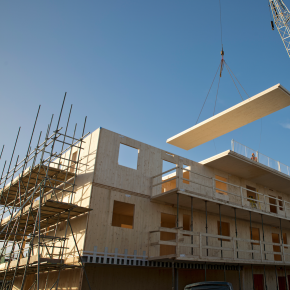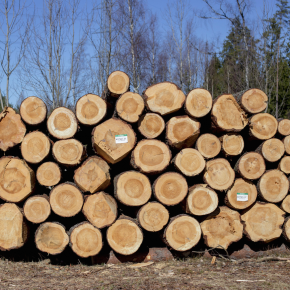
Sodra: Sustainable timber – the smart, affordable, fast way to build UK homes
Jeremy English, Great Britain and Ireland Manufacturing Sales Director at Södra, explores how timber can facilitate less expensive, more efficient and attractive construction.
“We all, of course, know the problem of the UK facing an unprecedented shortfall, and a historic backlog, of accessible new housing. But the question ‘what can we do to mitigate this shortfall?’ is more nuanced.
To begin to understand the problem clearly, we need to consider that multiple factors are at play – not least considering how new homes can be constructed better.
Running the numbers
Originally, the 2015 government’s goal was to deliver one million dwellings by the end of 2020; that equates to around 200,000 new homes per annum. In 2016 this target rose to 300,000 new homes annually for the foreseeable future (Building More Homes Report 2016).
In December 2018, parliament issued another sobering briefing. ‘Tackling the under-supply of housing in England’ examines some of the key barriers and potential solutions to increasing housing stock England.
It also affirmed estimates that England needs between 240,000 and 340,000 new homes per year. Yet in 2017/18, the total housing stock in England increased by just 222,000 homes: admittedly a two per cent uplift on the previous year, but still an ongoing shortfall against the annual estimated need.

Driving a change
No matter how many new homes we build, if buyers can’t afford them, the problem just gets worse. Research from the Institute of Fiscal Studies suggests that 40% of young adults cannot afford to buy one of the cheapest homes in their area. The proportion of 25 – 34 year olds who own a house has dropped from 55% two decades ago to just 35% (at the time of writing).
Building homes faster and widening the range of construction methods is one way the industry can change this.
At the same time the government, and the housebuilding industry, also face challenging environmental pressures. For instance, the Committee on Climate Change (CCC) reports that 18% of UK carbon emissions come from buildings – mostly homes – with a further 15% of emissions generated by electricity consumed in them.
The ways that homes are constructed, the building fabric and materials used, and the energy efficiency of the completed dwelling are now more important than ever.
Timber construction is good. Sustainable timber construction is better
Building with high-quality, sustainably-sourced timber can help combat all of the above issues. Light, versatile and sustainable, wood is both renewable and a carbon-neutral construction material.
Compared to brick and blockwork, timber construction is faster and cleaner. Even better, responsible forestry (such as that practised by Södra) ensures a sustainable source of material supply.
A known, trusted provenance and slow growth cycle means all timber purchased is stronger, more durable, and has fewer knots and imperfections.

Efficient offsite manufacture
Offsite manufacture and modular construction is poised to turn UK housebuilding on its head. Fully finished prefabricated timber frame building sections, typically pre-insulated Structural Integrated Panels, are created off-site, in a fabrication facility, and shipped to the site on demand to be fixed together.
Modular homes not only cut construction time by up to half, they also require less labour and materials, which typically reduces cost. Because panels are factory-built, in dry conditions, quality control is exceptional.
Since the structural element is renewable timber, not concrete, block or steel, the carbon footprint is dramatically reduced. The government has already recognised the immense potential.
Lower embodied energy
Then there’s embodied energy. Timber offers the lowest embodied energy rating of any mainstream building material. For example, a wooden floor beam requires around 80 megajoules (mj) of energy per square metre of floor space and emits 4kg CO2. By comparison, a square metre of floor space supported by a steel beam requires 516mj and emits 40 kg of CO2, while a concrete slab floor requires 290mj and emits 27kg of CO2.

Easy to work with
Unlike stone or steel-based materials, timber is light, versatile and is easy to handle, manoeuvre and install. Construction is typically faster, less expensive and less disruptive. In urban and brownfield developments, sites are usually quieter, calmer and cleaner.
Aesthetically pleasing
Timber framing and cladding offers architects, developers and buyers free rein to design – or refine – new homes creatively and sympathetically – without breaking the bank or contradicting local planning requirements.
Timber naturally grows more slowly in colder climates, resulting in tighter growth-rings. This not only signifies stability and strength but also provides an additional design feature. It offers a wide range of aesthetics that give great design flexibility.
It can vary in colours and texture, can be painted in any colour, waxed and varnished, carved, cut, glued and nailed or just left as it is.
A timber framed building can be one of the most beautiful types of structure possible. Timber can also be clad in external materials, allowing it to complement specific local regulations and planning requirements.
A better future – home grown
The construction sector has changed little for decades – but the time for complacency is gone.
As the pressure to address the UK’s housing crisis rises, and margins become even tighter, developers and construction companies need to open their eyes to opportunities, efficiencies, quality improvements and savings of sustainable timber-based construction techniques.
Address: Södra Wood Ltd, Unit 18/19, Cirencester Office Park, Tetbury Road, Cirencester GL7 6JJ
Phone: +44 (0)1285 646000
Fax: +44 (0)1285 646020
Email: [email protected]
Visit Supplier's page
Latest news

18th April 2024
Abloy UK showcases new digital portfolio at The Security Event 2024
Abloy UK is set to unveil its latest line-up of access control systems at The Security Event 2024, welcoming guests to explore its cutting-edge electromechanical and digital solutions on stand 5/F50.
Posted in Access Control & Door Entry Systems, Architectural Ironmongery, Articles, Building Industry Events, Building Industry News, Building Products & Structures, Building Services, Doors, Exhibitions and Conferences, Facility Management & Building Services, Health & Safety, Information Technology, Retrofit & Renovation, Security and Fire Protection
18th April 2024
Strand is a Failsafe Choice for Emergency Exit and Panic Hardware
In times of emergency, you’re in safe hands with Strand Hardware. Although there are many considerations for building specification, few decisions can be as critical as selecting the right emergency exit/panic hardware.
Posted in Access Control & Door Entry Systems, Architectural Ironmongery, Articles, Building Industry News, Building Products & Structures, Building Services, Doors, Facility Management & Building Services, Health & Safety, Restoration & Refurbishment, Retrofit & Renovation, Security and Fire Protection
18th April 2024
MRA appoints Callum Budd as Research Projects Director
MRA Research, the research agency focused solely on the construction sector, welcomes Callum Budd as its new Research Projects Director.
Posted in Articles, Building Industry News, Information Technology, news, Recruitment, Research & Materials Testing
16th April 2024
Mitsubishi Electric set to host CIBSE Journal webinar
Mitsubishi Electric will host a CIBSE Journal webinar on Wednesday 24th April 2024 at 1pm to discuss the legislation and initiatives driving changes in the way we will need to heat, cool and ventilate large commercial buildings to reach net zero emissions in the UK.
Posted in Air Conditioning, Articles, Building Industry Events, Building Industry News, Building Products & Structures, Building Regulations & Accreditations, Building Services, Facility Management & Building Services, Heating Systems, Controls and Management, Heating, Ventilation and Air Conditioning - HVAC, Information Technology, Pipes & Fittings, Plumbing, Seminars, Sustainability & Energy Efficiency, Training
 Sign up:
Sign up: